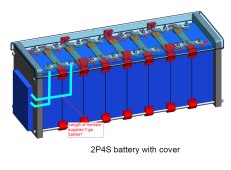I really don't get the hangup on the Paralleled Battery Packs using JK or any other respectable BMS. As long as the system is properly "built" with equal length wire, each pack is independently fused with the "correct" fuse there really should be no issues, many of us are doing it.
Batteries in Series has always been a challenge and moreso depending on the chemistry involved and that has lead to a lot of "bafflegab" and confusion. With the Battery Tech we are using here which is mostly LFP, there is little need to place batteries in Series unless people are purchasing Prebuilts and even BattleBorn has made this clear as to limitations and they actually support limited Series Batteries. Below is an extract on Paralled Batteries.
There IS a GOTCHA with Parallel Packs in a Bank and this is what I believe is the underlying troublespot here.
Example: If a bank of 3 packs is running along and is at 75% and 1 pack disconnects for whatever reason, the other two will continue and take the extra charge/discharge without consideration. The "down" pack will remain at 75% until the problem is resolved (unless the failure is draining it). Once corrected and being put back "online" the SOC Differential can create havoc within the bank resulting either in a Surge out if the other 2 packs are at a lower SOC or a large surge inbound from the 2 packs because they are at a higher SOC. In Both of those instances, the Instant Rush can exceed the individual BMS capabilities resulting in Damage and even releasing the Magic Smoke.
This is one of the major downsides of using FET Based BMS', as Relay-based ones just drop the Relay/SSR instantly when required, disconnecting the pack and no FETS get smoked. In that instance the Relay/SSR Capacity is the limiting factor and which can be 200-1000A or more and why they are used in EV's that push/pull a lot of juice.





